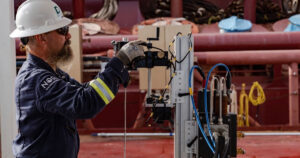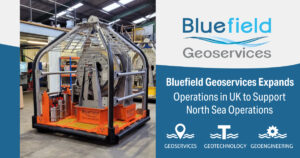The seabed environment poses well-documented challenges for offshore developers. The build-out of safe and sustainable offshore infrastructure hinges on the robust geotechnical analysis of seabed soil and bedrock conditions. After all, offshore assets, be them oil platforms or wind turbines, typically tower hundreds of meters above their foundations and are constantly subjected to considerable (and variable) environmental lateral loads and geohazards.
This makes thorough in situ seabed site investigation fundamental to offshore planning, especially as developers continue to explore deeper waters. Further, mounting environmental concerns only heighten the need for precise and reliable data.
But gathering seabed soil samples is no easy task. Critical data not only relies on the right geotechnical expertise, but the right technology.
For Bluefield Geoservices, founded in 2018, it was our team’s uncompromising commitment to data quality that set us on a path of developing some propriety technologies, such as the ROVcone and BOXcone, designed to carry our specific sampling activities in a range of complex seabed environments.
CPT STANDS THE TEST OF TIME
However, as history attests, new technologies do not always cancel out existing ones, and one of the more transformative in situ techniques used to assess seabed soil strength over the last 40 years is CPT (Cone Penetration Test) analysis. CPT has played a pivotal role in offshore soil investigations, notably when it comes to oil and gas E&P. However, recent projects, establishing operations at new depths, have shifted focus from piled jacket structures or jack-up platforms to new structures such as gravity base platforms, floating structures and seabed structures anchored by suction piles.
This puts increased emphasis on in situ seabed testing and, increasingly, geohazard assessment. Or, in other words, remotely operable CPT platforms—capable of “over the horizon” operations—are in increasingly high demand by offshore developers.
And then there is the burgeoning offshore renewable market, especially offshore wind. And especially in the US. The implications of this year’s public policy pledge to deliver 30GW by 2030 is historic and should create, beyond a significantly greener energy mix for millions of Americans, tens of thousands of jobs, billions of dollars in capital investment, and a new rooster for CPT service providers.
The number of turbines required in the US by the close of this decade—be them monopile, jacket, twisted jacket, tension-leg floating platform, semi-submersible platform, or spar-buoy—remains unclear, but a new era of offshore wind development walks hand in hand with the need to further investigate seafloor conditions up and down the continental shelf and deploy the tried-and-tested geotechnologies available.
ROSON 100 CPT
One such stalwart of the geotechnic toolkit is the ROSON 100, manufactured by a.p. van den berg. This highly versatile seabed CPT system can be deployed via an A-frame, over the side, or through a moon pool, and is widely considered the ideal choice for deep push testing or geotechnical route surveys on projects where assured penetration into challenging soil conditions is required.
Bluefield Geoservices’ ROSON 100 was recently transported from the UK to Rhode Island to support our US operations and help serve some of the immediate needs of our offshore wind customers in the northeastern United States.
The compact and electrical wheel drive system pushes the pre-assembled CPT string into the seabed with a force of 100kN in water 4-10 Te (with ballast), while a self-tensioning electric winch with heave compensation feeds the umbilical for power supply and data communication. A CPT depth up to 20-30 meters is achievable, depending on the soil conditions and reaction force, and the system is depth rated to 3,000 meters.
While the system still requires personnel onsite for system calibration, deployment, and the collection of physical samples, the ROSON 100 does cater for a significant down-manning of at-sea operations and, subsequently, the reduction of associated carbon emissions.
Bluefield Geoservices US is bolstered by a number of strategic alliances, including CSA Ocean Sciences and Ocean Specialists, Inc., which enables us to offer a fully integrated approach to subsea survey and site investigation services to the offshore energy, infrastructure, government, and scientific markets.
Learn more about our Shallow Geotechnical Services and download the 100kN ROSON CPT specification sheet.




